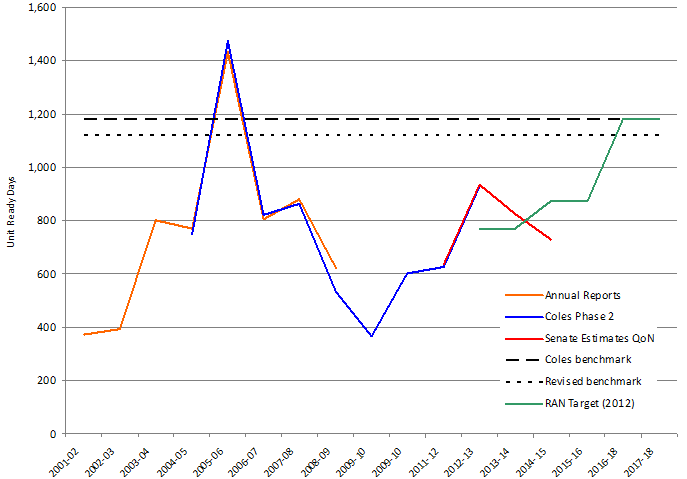It’s hard to say which is worse: the Navy’s attempt to hide its performance behind a cloak of secrecy or its abject failure to do so effectively. Back in late 2012, it was possible to reverse engineer a chart in the Coles Review to show the annual number of Unit Ready Days (MRD) achieved by the Collins fleet for three years beyond the last deliberate disclosure in the 2008-09 Defence Annual Report. Well they’ve done it again—this time in an answer to a Senate Committee question-on-notice, providing us monthly data all the way up to February this year.

The chart above shows the results. Note that the last data point is the rolling annual average as at February 2015. The good news is that the remediation of Collins sustainment appears to be delivering improvements commensurate with Navy’s plan to get up to the international benchmark of just under 1,200 days per year from its fleet of six boats. That said, the benchmark appears to have slipped down to about 1,120 in the latest data—we’re not sure what’s going on there.
The uptick in availability shows that we’re now starting to see a maturity in the approach to maintaining the Collins fleet that was sadly lacking over its first decade in operation. The complexity and cost of being a parent nation has finally sunk in, and the current effort doesn’t just look good, it’s delivering. That’s a substantial improvement on what we saw late last decade. To see how far we’ve come in terms of our understanding of the task at hand, it’s worth revisiting what the Navy was telling the Parliament (PDF) in 1999. Back then it expected (or at least expected to be believed) that:
‘…when the mature fleet of six Collins submarines was available, five could be expected to [sic] available for operations at any given time, and, as the Collins were significantly more capable than the Oberons, it would therefore provide a much greater overall submarine capability.’
That prediction is totally at odds with the ‘rule of three’ that forms the usual approach to managing submarine fleets. If, as expected, the Future Submarine fleet grows in numbers, it’ll still be governed by that rule of thumb. The government understands that as well, expecting that:
‘…two submarines are in full cycle docking at any one time, with, in general terms, one and sometimes two in shorter dockings and maintenance. This means Defence can currently plan on having two and sometimes three submarines available to the Fleet Commander for tasking at any one time.’
Let’s be clear: we wouldn’t be putting submarine availability data out in the public domain (or, more accurately, repackaging data that’s already out there) if we thought it was at all likely to jeopardise national security. Any would-be adversary also understands the rule of three and can take an educated guess about the number of Australian submarines that might be out and about at any given time. And even if it isn’t sure about the status of one or two of the boats, prudent planning would require a working assumption of more rather than less.
Finally, we’re reporting on past availability performance, which doesn’t reflect what’s happening today. We think this is pretty clearly a case of “official’s secrets” rather than “official secrets”.